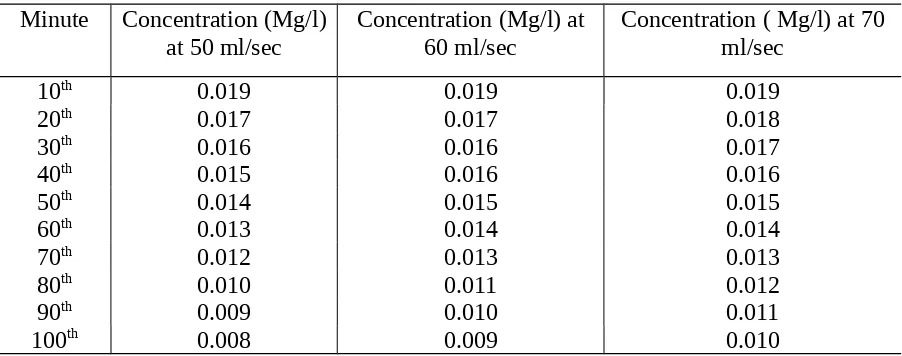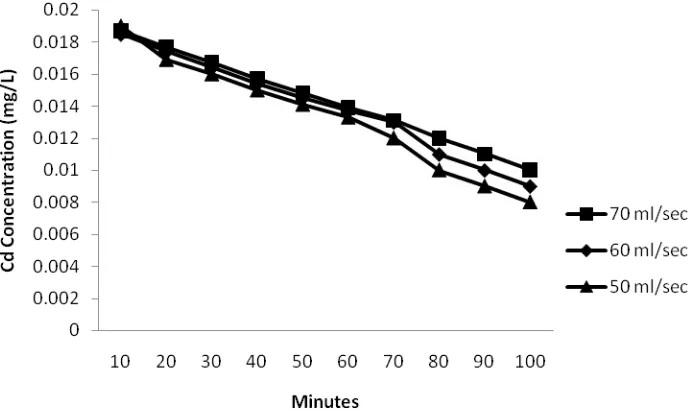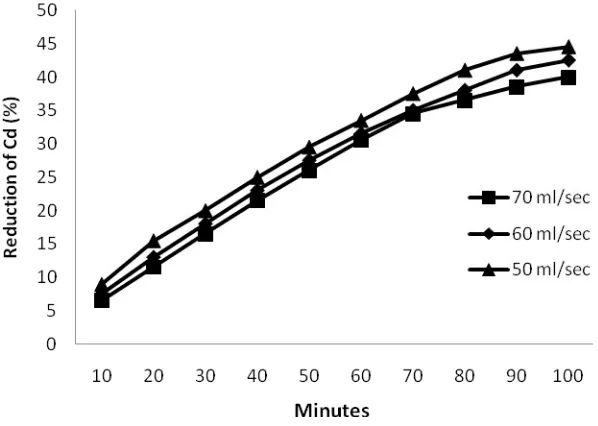THE ABILITY OF WATER PLANT IN REDUCING HEAVY METAL CADMIUM (Cd), Pb and Cr AT A CONTINUOUS FLOW
Rusnam
Lecturer of Agricultural Engineering, Faculty of Agricultural Technology Andalas University, Padang
Abstract
Water is an important role for human being and other creatures. A water surface like river can be used for the needs of human as a place of saving water, irrigation, livestock, raising fish, industry needs, housing, and recreation. Therefore, the use of water to those needs has to be done wisely by considering its use to the future. The contamination of water can reduce the quality of the water itself and it can not be used for the needs of agricultural sector as well. One of the contaminations comes from a heavy metal like cadmium (Cd), Pb and Cr. This research was done to reduce the use of heavy metal toward a water hyacinth plant (Eichornia crassipes Solms) with a continuous flow where the heavy metal which is set aside is cadmium (Cd), Pb and Cr. In this research, there are variations of debit such as at 50ml/sec, 60ml/sec, and 70ml/sec. The measurement of the sample was done in the minutes 10, 20, 30, 40, 50, 60, 70, 80, 90, 100. The result of the research showed that water hyacinth plant (Eichornia crassipes Solms) can cure water quality that has been contaminated by cadmium (Cd), Pb and Cr until it reached below the standard of agriculture. The highest efficiency of elimination came from the treatment with a debit 50 ml/sec with 44.5% for Cd, 44.5% for Pb and 44.5% for Pb meanwhile the lowest came from a debit 70 ml/sec with 40% for Cd, 44.5% for Pb and 44.5% for Pb.
INTRODUCTION
Water is an important role for human being and other creatures. A water surface like river can be used for the needs of human as a place of saving water, irrigation, livestock, raising fish, industry needs, housing, and recreation. Therefore, the use of water to those needs has to be done wisely by considering its use to the future. Water is the best solvent so that it always contains lots of solution, non-solution and microorganism. If the content of various substances or microorganism in the water exceeds the standard of the water itself, so its quality can be contaminated and it can not be used anymore. Water that is being disturbed on its quality can be said as “get contaminated” (Effendi, 2003). In agricultural sector, the water quality must be noted so that it cannot give a negative effect on crops. The contamination can reduce the quality of water so that water cannot be used for the needs of human being and agricultural sector as well. One of the rivers that have been contaminated is Batang Harau, located in Padang, West Sumatera.
The contamination possibly happened due to the mining process of PT Padang Cement, it contains cadmium (Cd). The content concentration of cadmium in Batang Harau River is about 0.024 mg/l until 0.249 mg/l (Hamid, 2014). Meanwhile, at the act of Government Regulation No. 82 Year 2011 stated that the content of cadmium concentration allowed is no more than 0.01 mg/l. The concentration that was found exceeds the standard, in other hand, that river is used for irrigation. Cadmium (Cd) absorbs through the tissued of the crop in a little amount but it will increase slowly and destroy the tissue intil it died. Cadmium will be dissolved and half of it will be absorbed to the soil and at crop’s metabolism, it will accumulate all tissues. The indication of the excess of cadmium will poison the crops, as the research of Jing Dong, Wu Fei-bo, and Guo-ping Zhang in 2005 showed that heavy metal Cd can reduce height of crops and volume of roots significantly and it also blocks the activity of photosynthesis.
alternative by using phytoremediation. Phytoremediation is the use of crop to remove, displace, stabilize, or to destroy a pollution compound, either in organic or inorganic (Priyatno, 2007). This technology is an advanced and gives many advantages. This technology is also safe to be used, cheap cost, can reduce the volume of contaminant, and give a direct impact for society’s sanitary. The greatest impact is the cheapest cost compared to other processing such as insineration, washing of soil based-on chemical system and the energy that is needed. Some weeds such as water hyacinth, wood lettuce, water lilies and azolla can be functioned as phytoremediator to absorb a toxic particulary for heavy metal that exists in the waste. However, the charactersitcs of water hyacinth that is fast-growing and the habitats becomes its superiority as a medium to control water contamination. Other than that, water hyacinth also binds a heavy metal. The previous studies has been conducted by the researchers by using water whycinth (Eichornia crassipes Solms), but in the puddle place. And the result showed that water hyacinth was an effective crop to reduce a meavy metal, including Cadmium (Cd). Based on the explanation above, then the writers has conducted a research about the ability of water hyacinth in reducing the content of heavy metal cadmium (Cd), in a continious flow with a title; The ability of Water Hyacinth Plant (Eichornia crassipes Solms) in Reducing Heavy Metal Cadmium (Cd) at a Continious Flow
MATERIALS AND METHODS
This research will be done in Perumnas Belimbing Kuranji, Jl. Anggur aya No. 24 Kuranji, Padang at Juni – August 2016 . Then, the analysis content of Cadmium (Cd) is done in Water Laboratory, Environmental Engineering, Andalas University, Padang.
This research uses water hyacinth that is taken from the pond near Ulu Gadut, Padang, aqudes and thick solution of Cadmium (CdSO4). The tools that are used in form of plastic as the medium of water hyacinth, SSA (Spektrofotometer Serapan Atom) or (Spektrofotometer of Atom Absorption), measuring cup 100 ml, measuring cup 200 ml, volumetric flask 250 ml, measuring pipette 10 ml, micro pipette, wooden stirrer, and stationary.
with the concentration of Cadmium that is found in Batang Harau River, Padang (Hukama, 2014) with variety of debits.
The things that have to be prepared to conduct this research are the design, and installment of reactor, condition of reactor and the preparation of artificial solution CdSO4. Reactor that is used in this research is made of laboratory scale. Three reactos are used with the function to shed three different debits. All of the reactors are planted by water hyacinth and is located at the variety of debit that is flowed. The swiftness of the flow is based on the design criteria proposed by Susumu Kawamura (1991), a slow filteration (0,17-0,42) m/h. The size of reactor is 70 cm x 60 cm and is divided into 3 rooms. The first room has measurement of 15 cm x 60 cm x 40 cm, as an inlet to keep the laminar flow, the second room has a measurement of 40 cm x 60 cm x 30 cm, as a processing room and the outlet room with the measurement 15 cm x 60 cm x 40 cm, to retain water from the yield process before it is flowed to an outlet tap.
Reactor that is used has a function as spot of manufacturing artificial solution that uses water hyacinth. The reactor has a form as rectangle and it is made of a transparent fiber glass. Reactor is equipped with some tools such as: tank of artificial solution, used to retain artificial solution that is used during the process. Tank of artificial solution has a form as cylinder and it is made of plastic with a diameter 80 cm and volume 220 litres.
1. An inlet tap that is placed at tank of aritificial solution
2. An outlet tap has a function to shed aritificial solution from the yield of reactor to the pail as intercepot.
3. A small bucket with volume 3 litre, used to retain the yield of reactor.
It uses water hyactinh (Eichhornia crassipes) that is growth on the pond near Ulu Gadut, Padang. The height of the crop that is used around 20 cm. This crops is easily grow and fast-adaptation.
sample got from the previous analysis at Batang Arau River, Padang and it is got at 0.2 mg/L. The data achieved from the reduction yield of cadmium content by using water hyacinth will be used to design the installment of water waste processing
RESULTS AND DISCUSSIONS Treatment of the Research
The measurement of heavy metal Cadmium (Cd) at water that is used as a media of water hyacinth before the treatment by using cadmium concentration 0.2 mg/L. The tool that is used to measure the water sample is SSA (Spektrofotometer Serapan Atom) or Spektrofotometer Atom Absroption. After the analysis, the velocity of the treatment is conducted or the debit from the container of waste to the container of water hyacinth. The treatment of water debit conssits of three levels; 50 ml/ sec, 60 ml/sec, and 70 ml/sec
Result of the Analysis
The result of the treatment of water sample is presented in the average concentration (content) of heavy metal cadmium in the solution (a research container) at 50 ml/sec, 60 ml/sec, and 70 ml/sec debit during the observation can be seen in the Table 1.
Table 1. The Content of Cd in the Solution at 50 ml/ sec, 60 ml/sec, and 70 ml/sec Minute Concentration (Mg/l)
at 50 ml/sec Concentration (Mg/l) at60 ml/sec Concentration ( Mg/l) at 70ml/sec
From the Table 1, it is seen that the average concentration (content) of cadmium in the research container at 50 ml/sec debit during the observation is decreased. That reduction started from the first research or when the date was taken. At 80th minute, the content of Cadmium in the solution is at in the standar of water quality for agriculture where it is at 0.01 mg/L. Then, it is seen that average concentration of cadmium at a container research at 60 ml/sec during the observation is also the same with the reduction at 60 ml/sec. However, this reduction is slower than the treatment at 50 ml/sec. Even though it is slow, the standard quality of water for irrigation still can be reached at taking the sample at 90th minute. It indicates that 10 minutes is slower than the treatment at 50 ml/sec debit. Later, it also can be seen the average concentration of Cadmium (Cd) in the research container by 70 ml/sec debit during the observation, the reduction is also the same with 50 ml/ sec and 60 ml/sec. Besides, it becomes the lowest reduction compared to the two, 50 ml/ sec and 60 ml/sec. Although it becomes the lowest reduction, the standar of water quality of agriculture is achieved at the end of the sample, 70 ml/sec.
The reduction of cadmium cocentration during the observation at 50 ml/sec, 60 ml/sec, and 70 ml/sec can be seen in the Figure 1.
Figure 1. Graph Reduction of Cadmium Concentration at 50 ml/sec debit
pattern. It indicates that the treatment of phytoremediation by using water hyacinth is a choice to reduce the concentration (content) of cadmium in the waterworks. At 50 ml/sec debit, it shows that the standar of water quality for agrilculture can be achieved at 80th minutes and continuously the reduction occurs. The efficiency level of heavy metal cadmium can be achieved from the reduction of initial concentration to the end of concentration and it is divided by the initial concentration, then it is multiplied by 100%. Then it shows the reduction of cadmium concentration is always constant from 10th minuted to 100th where it also happens for the lower debit at 60 ml/sec although the reduction of cadmium shows the same pattern, except the sample at 40th and 50th minute. It means that the treatment of phytoremediation by using water hyacinth is a choice to reduce the concentration of Cadmium (Cd) in the waterworks. Besides, it is seen that the reduction of cadmium concentration can be achieved as well at 70 ml/sec debit, with the same pattern at 50 ml/ sec and 60 ml/sec and it is always constant from 10th minute to 100th. It then indicates the treatment of phytoremediation by using water hyacinth with 3 treatment of debit from 50 ml/sec until 70 ml/sec is one of the choices to reduce the cadmium concentration in the waterworks.
Then the graph percentage of effeciency level of cadmium concentration at 50 ml/sec, 60 ml/sec, and 70 ml/sec
CONCLUSION Based on the result and the analysis, it can be found;
1. Water Hyacinth can heal the contamination water by heavy metal Cadmium (Cd) until it comes under the level standar of water quality of agriculture.
2. The highest reduction efficiency can be achieved at the treatment with 50 ml/sec debit at 44.5%. Meanwhile, the lowest reduction efficiency can be achieved at 70 ml/sec at 40%.
ACKNOWLEDGEMENT
The writers thank to the Dean of Faculty of Agricultural Technology Andalas University who has given a fund so that this research can be conducted well.
COMPETING INTEREST There is no conflict interest in making this article.
AUTHOR BIOGRAPHY
I am Rusnam, a lecturer of Agricultural Engineering majoring in Water Quality of Agriculture,
REFERENCES
Al Layla, MA. 1978. Water Supply Engineering Design. Michigan: Ann Arbor Science.
Arsyad, S. 1989. Conservation of Soil and Water. IPB : Bogor.
Darmono. 2001. Environmental Living and Contamination, The Relation of Toxicology of Metal Compound. UI-Press. Jakarta.
Department of Health Republic Indonesia. 2010. A Decree of Ministry of Health.No. 907/Menkes /SK/ VII/2002 About the Requirements and the Surveillance of Water Quality.
Hamid, Hukama. 2014. Variety Analysis of Spacial Concentration of Heavy Metal (Cd), Plumbum (Pb), and Cromium (Cr) in Batang Harau River, Padang, West Sumatera. A Thesis. Environmental Engineering Department. Faculty of Engineering, Andalas University, Padang.
Harahap, S. 1991. Level of Contamination of Kali Cakung Observed From Its Physical and Chemical Charateristics Especially Heavy Metal and Diversity of Beenthos. A Thesis. Bogor: Post Graduate Program. Bogor Agriculture Institue.
Hardyanti, Nurandani et. al. 2006. Phytoremediation Phospat by using Water Hyacinth (A Study at Solid Waste)UNDIP: Semarang.
Hutagalung, HP. 1991. Contamination of Sea by Heeavy Metal, in the Status of Sea Contamination in Indonesia and Its Monitoring. P30-LIPI.Jakarta.
Mangkoedihardjo, S. 2005. Fitotechnology and Exotoxicology in Operation Designing of Waste Composting. National Seminar of Environmental Technology III ITS, available at , (http://www.its.ac.id/sarwoko-enviro-Seminar%20sampah%20TL.pdf. [15 April 2012].
Mulyanto, H.R. 2007. Its Function and Characteristics.. Graha Ilmu: Yogyakarta. River,
Najiyati, S and Danarti. 1992. A Direction to Shed and Splash the Crop. Penebar Swadaya. Jakarta
Priyanto, B. & Prayitno, J. 2006. Phytoremediation as a Recovery Technology of Contamination, Especially at Heavy Metal, availabe at (http://ltl.bppt.tripod.com/sublab/ lflora1.html, [21 Februari2011).
Rusnam, Neni and Bustanul Arifin. 2009. Bioremediation Technique of Water Contamination Controlling of Lake Maninjau, West Sumatera. A Report . 2009.
Rusnam, Asmiwarti and Maidar Pratomo. 2013. Reduction of Metal Mercury Concentration by The Plant’s Mata Lele (Azolla pinnata R. Br.) for Irrigation Water. Prosiding : The International Symposium on Agricultural and Biosystem Engineering (ISABE) 2013. Rusnam, Asmiwarti, Efrizal and Arda Sofiani. The Influence of Water Hyacinth to Decrease the
Heavy Metals Mercury (Hg) Concentration for Irigation. International Journal of Advanced Science Engineering Information Technology, Vol. 3 (2013) No. 6, pages: 23-25. (Terindex Scopus).
Sarief, Saifuddin. 1985. Conservation of Soil and Water. Pustaka Buana: Bandung.


